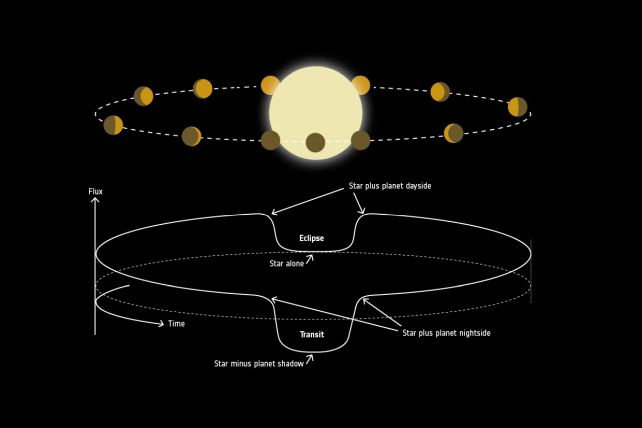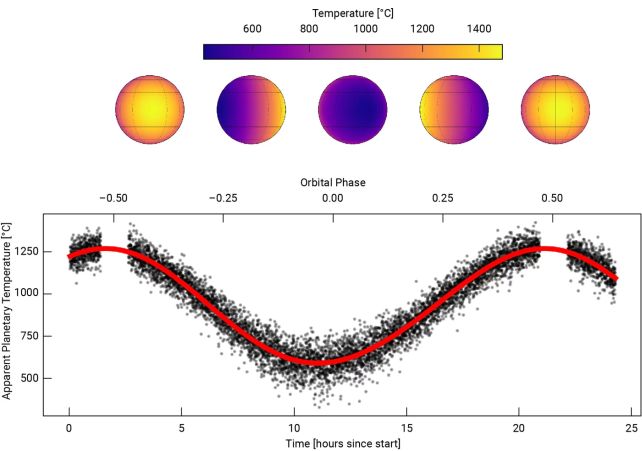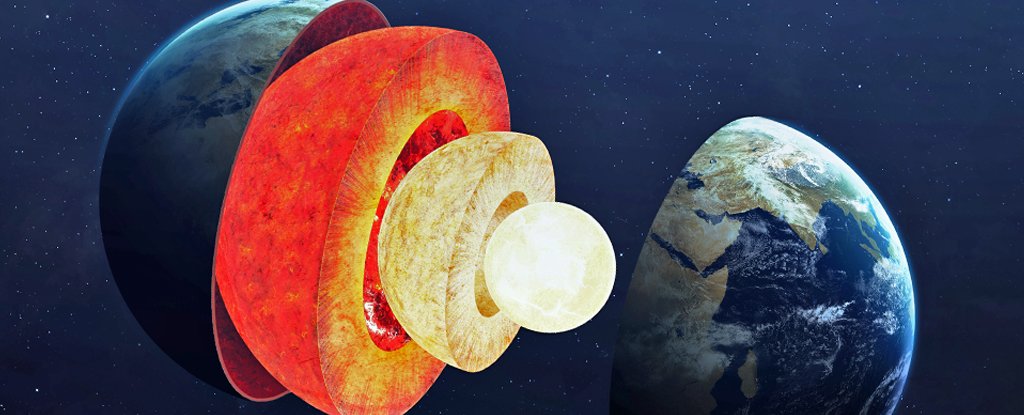ARTICLE AD
It's always dark and stormy on the nightside of the exoplanet Astrolábos.
There, in the permanent shadow facing away from its host star WASP-43, the skies of the gas giant also known as WASP-43b are scudding with crashing clouds, but that's not all. So close is the exoplanet to the star that its temperature, even at night, scorches with heat that vaporizes rock – meaning those clouds are likely made up of minerals.
"With the new observing power of JWST, WASP-43b has been unveiled in unprecedented detail," says astronomer Laura Kreidberg of the Max Planck Institute for Astronomy (MPIA) in Germany.
"We see a complex, inhospitable world, with furious winds, massive temperature changes, and patchy clouds likely made of rock droplets. WASP-43b is a reminder of the vast range of climates that are possible on exoplanets and the many ways in which Earth is special."
Astrolábos was discovered back in 2011, and at that time it was the closest orbiting 'hot Jupiter' exoplanet ever discovered, a world around the size and mass of Jupiter, but with an orbital period of just 19.2 hours.
These hot Jupiters are something of a puzzle: according to our understanding of planet formation, they're way too close to their stars to have formed in that position, since the radiation and winds from the star would have nipped any attempts to do so in the bud. This suggests that they may have formed at a greater distance, and somehow been moved to spiral inwards.
We've found enough hot Jupiters now to suggest that this process must be not uncommon. And their properties make them excellent laboratories for studying alien planetary systems. Many of them transit their host stars – that is, they pass between us and the star on their orbital path. And the short orbits mean that they do it a lot.
This means that we can probe their atmospheres. When a hot Jupiter passes between us and the star, some of the star's light travels through the exoplanet's atmosphere, where some wavelengths are absorbed or amplified by atoms and molecules. Scientists can look at the spectrum of light to see which wavelengths are stronger or weaker to determine what elements are there altering the light.
Changes in how bright the star's light is, and how it changes across the electromagnetic spectrum, can also reveal how much light is being emitted by the exoplanet, once the star's reflected light is subtracted, to reveal how much heat that exoplanet is giving off.
The signals are very, very small, though, and this is where the short orbital periods come in handy: the signals can be boosted by stacking the data of multiple transits, or an entire orbital period can be observed in one fell swoop.
 How an exoplanetary transit can be measured in the changing light of a star. (ESA)
How an exoplanetary transit can be measured in the changing light of a star. (ESA)This type of analysis has been previously performed for Astrolábos using Hubble data; astronomers at that time found evidence of water vapor in the exoplanet's atmosphere. Now the more powerful James Webb Space Telescope has had a go, and we know a lot more about what makes Astrolábos's atmosphere tick.
 JWST observed Astrolábos for 27 continuous hours to measure its temperature gradient. (Taylor J. Bell/ BAERI/NASA/MPIA)
JWST observed Astrolábos for 27 continuous hours to measure its temperature gradient. (Taylor J. Bell/ BAERI/NASA/MPIA)Using mid-infrared JWST observations, scientists were able to take the exoplanet's temperature. Because it is so close to its star, Astrolábos is what we call 'tidally locked': one side is permanently facing the star, burning in daylight, and the other is in permanent night. There's a steep temperature gradient between the two hemispheres. The dayside burns at 1,250 degrees Celsius (2,282 Fahrenheit), while the nightside is less than half that temperature, at 600 degrees Celsius (1,112 Fahrenheit).
This is a much steeper gradient than one would expect for a clear, cloudless atmosphere. Computational modeling confirmed it: the relatively cooler nightside of Astrolábos probably has clouds high up in its atmosphere, blocking much of the infrared radiation coming up from below. The day side, by contrast, is cloud-free; too scorchingly hot for clouds to form.
The JWST data also gave more insight into the composition of the exoplanet's atmosphere. It confirmed the presence of water; but also a search for methane yielded nothing, which was a surprise. Methane is expected to form on the nightside of hot Jupiters from reactions involving carbon monoxide and hydrogen.
The lack of methane on Astrolábos probably has to do with its temperature gradient, which would generate powerful winds up to 9,000 kilometers (5,000 miles) per hour. This would whip anything required to create methane past the nightside so quickly that the molecule literally wouldn't have time to form.
"If winds move gas around from the dayside to the nightside and back again fast enough," explains astronomer Joanna Barstow of the Open University in the UK, "there isn't enough time for the expected chemical reactions to produce detectable amounts of methane on the nightside."
This suggests that the atmosphere of Astrolábos is chemically consistent all the way around, an inference that couldn't be drawn from previous measurements. But the surprises the researchers found in that atmosphere suggest also that we need to be careful about making assumptions about what exoplanets might be doing.
Future research, they say, should try to explore the broader effects of asymmetrical heating on extreme, alien worlds.
The research has been published in Nature Astronomy.

 8 months ago
38
8 months ago
38 

